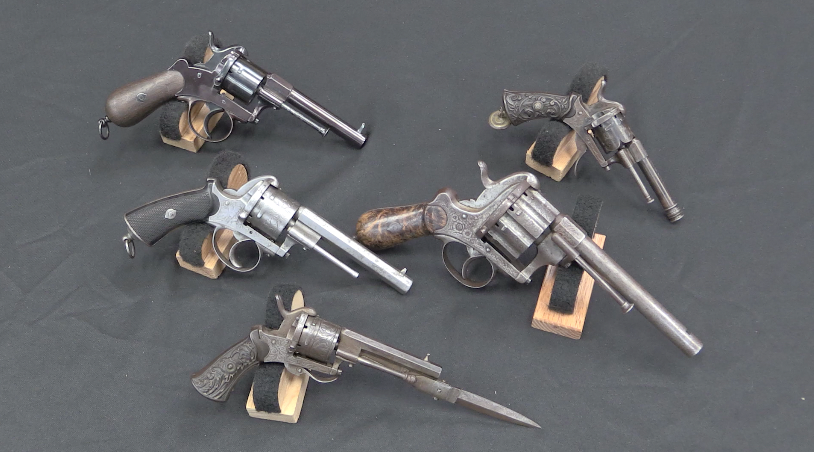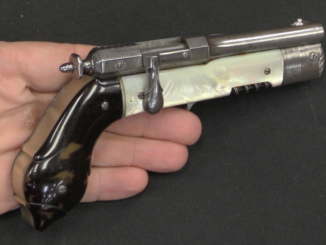This Lorenzoni-pattern rifle was presented to King Louis XV of France in the mid 1700s, and is an exquisite example of firearms deemed suitable for royalty at the height of the European kings. It is .38 caliber and rifled, with remarkably usable sights and a repeating mechanism with the ball and powder magazines accessible through a trapdoor in the back of the stock. The barrel is made of a gorgeous damascus steel, with the whole of the gun adorned with silver inlay, engravings, and deep wood carvings.
The gun was noted in the 1775 inventory of the French royal arms collection, but that collection was broken up in 1789 with the French Revolution. This rifle was rediscovered by an American officer in Europe in 1945, who noticed it in a pile on confiscated arms slated to be destroyed. He saved it from that fate and brought it home, where is stayed in his family until being put up for auction at James D Julia this year.




Hold it! If this was found in a pile of “potential terrorist guns to be scrapped,” then the guys doing the disarmament certainly had NO IDEA that antiques such as the Lorenzoni could not actually be used to kill people in the 20th Century (at least not kill people effectively)! This makes me wonder how many historical antiques were thrown into the fire as “confiscated terrorist guns.” Even today, the BATF would consider 18th Century-vintage flintlock muskets without modern serial numbers and markings to be “contraband definitely used by street gangs” on the basis that ALL GUNS WITHOUT SERIAL MARKINGS MUST BE GANGSTER GUNS.
No, the ATF doesn’t even regulate muzzleloaders as firearms so you’re good to not have serial numbers of any sort.
And given the context of Europe in 1945, when the Nazis were running out of weapons and desperately pushing obsoloete and makeshift arms into service, it made sense to confiscate anything that could be used as a weapon.
Not a muzzle loader.
Can’t count the number of times within the greater tragedy that was the world wars I’ve read or heard that phrase ‘destroyed/lost during/after the war. Personally I’d be more interested in one of those M1 .45 cal SMG’s in the background.
Keep your powder dry and your faith in God.
destroyed/lost during/after the war
As historical tidbit, during World War II Alfred Rosenberg (member of NSDAP) created entity called Sonderstab Musik
https://www.thestrad.com/the-stolen-instruments-of-the-third-reich/5470.article
which collected instruments dropped by fleeing musicians
Not really, anything made pre 1899 is an antique so the ATF doesn’t care. They may be jerks, but they’re bureaucrats first. As for the confiscation in ’45, more than likey it was found with arms being confiscated in Germany as part of the allies de-Nazification process. There was still a lot of concern about “werewolves” and the allies wanted to remove as many weapons from falling in the hands of pro-Nazi guerrillas post surrender.
I doubt anyone in post-surrender Germany knew how to operate a muzzle-loader. I can’t imagine a bunch of pro-Nazi militiamen (most of them kids) sticking up a GI with century old muzzle-loading percussion-lock guns. It would look absolutely stupid.
“Hey guys! Those kids say they’re going to shoot us with antiques if we don’t surrender!!” BANG! BANG! BANG!
“And they all stink at shooting. Just look at them reloading slower than dripping molasses! I think I’m going to die laughing.”
“I doubt anyone in post-surrender Germany knew how to operate a muzzle-loader.”
Also, it could be easily overlooked among other, more popular, fire-arms confiscated.
““Hey guys! Those kids say they’re going to shoot us with antiques if we don’t surrender!!””
And what if it is cleverly disguised Wunderwaffe?
Wonder weapons tend to fail in the hands of amateurs for obvious reasons. The moment any wonder weapon gets discharged it will be treated as a subject worthy of heavy bombardment. And don’t expect Hitler Youth scouts to be tactical geniuses with camouflage.
“Who in his right mind would disguise a Wunderwaffe as a muzzle loader? That’s boring! And it won’t work since the thing is too big!”
Anyway, I doubt anyone would trying to figure which particular weapon (pattern or rifle) enemy is firing on us, rather than where they are and what we could use to attack them.
Look at the Liberator pistol. The idea is one shot then steal the dead soldier’s weapon. A muzzleloader could facilitate the same deed
“broken up in 1789 with the French Revolution”
You cannot make a revolution in white gloves.
V.I.Lenin
Remember that the right to hunt was added to the french constitution after the revolution before that it was mainly a privilage of the nobles
Reminds me of going with my dad to hand in his stash of WW II trophies to the local bobbies during the “amnesty” in England. I was about 10 and the rozzer took us back into the warehouse to show us all the guns being cut up. There was a lot of British and German WW II stuff interspersed with flintlocks, shotguns with engraving and inlay, Hundreds of old small arms of all kinds, of incalculable worth, all being cut up and tossed into tubs. Heartbreaking to a small boy who had only handled 22’s at that point.